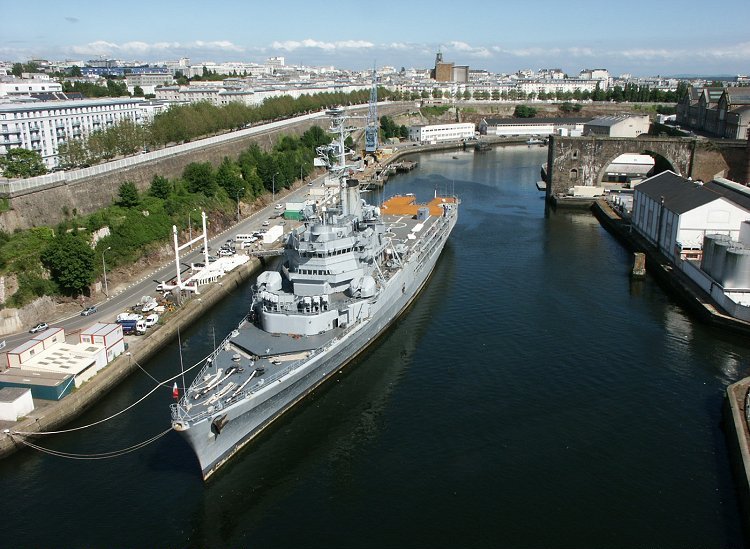The Arsenal de Brest is a collection of naval and military buildings located on the banks of the river Penfeld, in Brest, France. It is located at WikiMiniAtlas48°23′12″N 4°29′48″WCoordinates: 48°23′12″N 4°29′48″W.
Arsenal de Brest is also the headquarters of the French naval and oceanographic service.
Location and layout
Situated on the northern edge of the bay, Arsenal de Brest receives protection from a narrow goulet forming a natural harbour. The harbour is fed by the Penfeld river connecting it to the Atlantic Ocean. The submarine base at Île Longue is located south-west of Brest.
Arsenal de Brest history
Brest served as a supply base for the US troops in World War I. It was used as the disembarking port for most of the US forces in 1917.
The Germans set up one of their Atlantic submarine bases at Brest and used it as a harbour for warships and U-boats during World War II. After World War II ship-building resumed with the production of passenger ships.
Construction
The naval port was constructed between 1631 and 1635. The Powder Magazines, Cordellerie and Military Hospital were operational by 1674. The Troulan dock was built in 1683. Three Pontaniou docks and other naval structures were created in 1746.
The Bâtiment aux Lions was constructed in 1807 to accommodate the arsenal's magazines. Basin 6 at the Salou was built between 1822 and 1827 while Basin 7 was constructed during 1864-1865. The Penfeld port was closed for commercial boats and transformed into a military port in 1865. Brest built more than 150 warships in the 18th century.
Construction of warships at the port began in late 1950's, initially with destroyers. Some of the warships built were armoured cruiser Dupuy de Lome in 1895, the battleships Charles Martel in 1897, Charlemagne in 1899, Iena in 1902, Republique in 1906 and Democratie in 1908, and the heavy cruisers Leon Gambetta in 1905 and Edgar Quinet in 1911.
The French aircraft carrier Clemenceau built in 1961 was followed by the helicopter carrier Jeanne d'Arc in 1964. The aircraft carrier locks 3 and 4 were constructed in 1970. Brest built several destroyers and missile destroyers during 1960-1980. The French nuclear-powered aircraft carrier Charles de Gaulle was launched in 1994.
Arsenal de Brest operations
The nuclear-armed, ballistic missile submarine base at Île Longue in the Brest roadstead was opened in 1972. The base conducts routine maintenance, overhauls and repairs to the nuclear missile-launching submarine fleet of the French Navy.
Brest was also the home port of the Charles-de-Gaulle until the aircraft carrier was shifted to Toulon in September 2000. The naval port also houses the Brest Naval Training Centre.
Garrison facilities
Arsenal de Brest extends along both banks of the Penfeld, which is lined with docks.
The docks do not allow berthing of ships nearby due to the exposure of rocks at low tide.
Hence, berthing positions are arranged mostly on the left bank and small vessels are moored alongside these quays by using large cranes.
The Tourville Basin or Basin 1 located in the cove is now called a pool.
Basins 2 and 3 are located at Pontaniou cove while Basins 4, 6 and 7 are at the Salou area.
Quai d'armement and quai oblique docks, situated between Basin 9 and the entrance of Laninon, are served by five cranes. Both the docks are used to construct new ships, accommodate large navy vessels and maintain flood for any type of vessel.
The Flottilles wharf features eight docks used for the parking of minesweepers and sloops. Two pontoons embossed forward of the submarine base also accommodate warships.
Major overhauls of the ballistic missile submarines take place in Basin 10. Missiles and fuel are stored at Ile-Longue during overhauls. The aircraft carrier heads are now used to host large vessels.
Other facilities and services
The Brest Naval Training Centre (the Centre d'instruction naval de Brest, or CIN) at Arsenal de Brest is one of the key training centres of the French Navy.
The CIN includes the lycée naval, École de maistrance and seamen's training school. The Lycée trains students to enter French officer-training schools, while École provides training for future naval non-commissioned officers.

